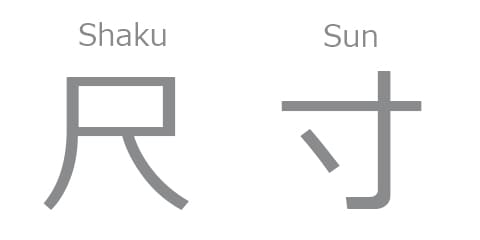Size of Taiko
|
|
1. How to Know the Taiko Size
-Nagado Daiko-
To know the size of the nagado daiko, measure the head diameter.

The unit of the measurement is "shaku". For example, if the head diameter of the taiko is 45cm, it is 1.5 shaku size.
Shaku & Sun"Shaku" and "Sun" are units of measure used for taiko drums. These units are not generally used in Japan anymore. The metric system of measures using the meter, centimeter and so on are the current standard in Japan now. However, taiko makers use "Shaku" and "Sun" when they make taiko drums. Shaku is pronounced as sha-ku. Sun is pronounced as su-ng.
1 shaku is about 30cm (1000/33 cm) *about 12in (about 11.93in).
1 sun is about 3cm (100/33 cm) *about 1.2in. (about 1.193in). 1 shaku is 10 sun.
Example (Head Diameter) 1 shaku is about 30cm *about 12in 1.1 shaku is about 33cm *about 13in 1.2 shaku is about 36cm *about 14in 1.3 shaku is about 39cm *about 15in 1.4 shaku is about 42cm *about 17in 1.5 shaku is about 45cm *about 18in 1.6 shaku is about 48cm *about 19in 1.7 shaku is about 51cm *about 20in 1.8 shaku is about 54cm *about 21in 1.9 shaku is about 57cm *about 23in 2 shaku is about 60cm *about 24in *There's a margin of error in length because it's handmade. |
-Shime Daiko-
To know the size of the shime daiko, measure the thickness of the head.

The word "cho-gake" is used. The bigger the number is, the thicker the head is. Only the smallest one is called namitsuke. 2 cho-gake is thicker than the namitsuke. So the thick head can be tensioned more, the sound produced becomes louder.
*Please note that the size of the shime daiko varies depending on the maker.
Namituske & Cho-gakeDifferent words are used for the shime daiko. The smallest size is called "namitsuke". "Cho-gake" is used for the bigger shime daiko than namitsuke.
Example (Thickness of Head) Namitsuke is about 11mm *about 0.43in 2 cho-gake is about 19mm *about 0.75in 3 cho-gake is about 23mm *about 0.91in 4 cho-gake is about 26mm *about 1.02in 5 cho-gake is about 29mm *about 1.14in *There's a margin of error in length because it's handmade. |
-Hirado Daiko-
Same as Nagado Daiko
-Okedo Daiko (Okedo / Katsugi Oke)-
Same as Nagado Daiko
-Odaiko (Odaiko / Ohira Daiko / Ojime Daiko)-
Same as Nagado Daiko
-Eisa Daiko (Odaiko / Shime Daiko / Paranku)-
Same as Nagado Daiko
-Uchiwa Daiko-
Same as Nagado Daiko
 |
Do you know the types of taiko? See also this article. Types of Taiko |
2. How to Find the Right Size
Since the body size is different depending on the person, the right size of the taiko depends on the body size of the player. You can find the taiko that suits you by the following way:
(1) Set the nagado daiko holizontally.
(2) Stand in front of it.
(3) Bend knees a little bit. Be careful not to stoop over.
(4) Hold bachi and put the tips of them on the center of the head.
If your arms are comfortable at this moment, the taiko should be good for you.
Height of Nagado DaikoHeight of the nagado daiko is generally calculated by multiplying diameter of head by 1.25 or 1.3. It depends on the taiko maker but Taiko Center uses 1.25.
Example (Height of Nagado Daiko) 1.3 shaku has about 49cm* about 19 in height 1.4 shaku has about 53cm* about 21 in height 1.5 shaku has about 56cm* about 22 in height 1.6 shaku has about 60cm* about 24 in height *There's a margin of error in length because it's handmade. Tip: The height of the taiko can be adjusted by using the stand. |

In the modern taiko performance, 1.4 shaku, 1.5 shaku and 1.6 shaku sized nagado are mostly used. If you want to play the nagado daiko with other players at the same time, we recommend you to use 1.5 shaku or larger nagado daiko.
 |
Do you know how to maintain taiko? See also this article. Maintenance of Taiko |
 |
Are you looking for bachi sticks for these? See also this article. Types and Material of Bachi |
😚Thank you for reading this to the end. Please feel free to ask any questions or leave any comments😉
















